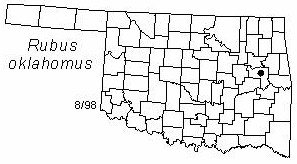Arching, upright shrub to 1 m (3 ft) in height. Twigs long and slender, may root at the tips; terete or angled; many straight or curved prickles, 3-6 mm (1/8-1/4 in) long. Leaves opposite, palmately compound, 3-5 foliate; leaflets broadly oval, lower pairs rhombic, about 7 cm (2.75 in) long and 4 cm (1.4 in) wide; sparse pubescence above, gray pubescence beneath; rounded at base; obtuse or nearly so at apex; margins obtusely apiculate; petioles and rachis have many straight or curved prickles. Inflorescence of 3-5 flowers, pedicels pubescent with many straight or bent prickles; flowers about 3 cm (1.2 in) in diameter; calyx 5-lobed, very broad, apiculate, becoming reflexed; petals 5, large, broad and rounded; pistils many, inserted on hypanthium; stamens numerous; flowers appear from April to June. Fruit an aggregation of drupelets.
Distribution: Oklahoma.
Habitat: prairies and woodland margins.
Comments: Rubus is a Roman name meaning red; oklahomus refers to the state of Oklahoma.
Field identification: Rubus is a complex genus. Species are difficult to identify due to frequent hybridization and introgression.
Food use: fruits are eaten raw or made into jams and jellies.
Wildlife benefits: blackberry fruits are eaten by many species of birds and mammals. Its dense growth provides excellent cover.
NWI status: none
Distribution in Oklahoma: 
BACK
NEXT
RETURN TO INDEX
Last update: 9/17/99
 Go to Oklahoma Biological Survey Home Page
Go to Oklahoma Biological Survey Home Page
 Disclaimer
Disclaimer